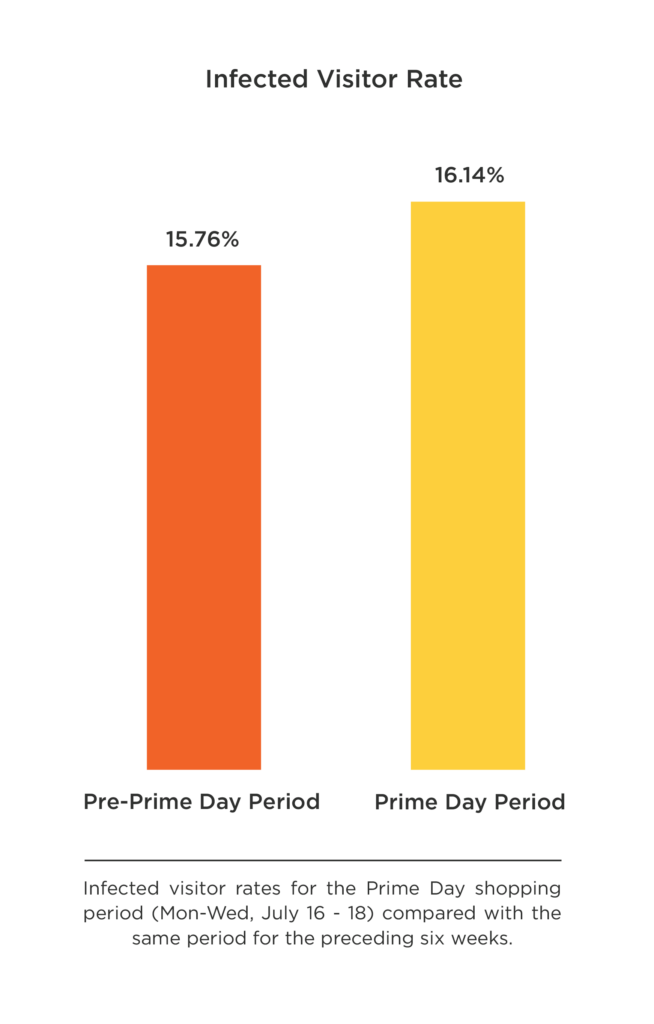Prices were not the only thing that crashed this past Prime Day period — but it still didn’t stop Amazon from making a historic online splash.
With their servers unable to support the surge in traffic, Amazon experienced several technical failures just 15 minutes into the 36-hour Prime Day sales period – making it impossible for shoppers to navigate their site or app, add products to their cart, or complete checkout. The largest issues took place within the first 63 minutes of the sale.
Regardless, none of these issues kept their loyal legion of customers from coming back to take advantage of promotions: Sales for the online marketplace behemoth surpassed its previous biggest shopping days (including all previous Cyber Mondays, Black Fridays and Prime Days), and en route to netting more Prime members on July 16 than any other day in its history.
Does a rising tide lift all boats? What our data reveals
The mounting success reaped by Amazon in its past Prime Day periods has galvanized other online retailers and marketplaces as well, many of who launched significant sales events during the same time this year, making it an industry-wide phenomenon.
How did the Prime Day frenzy impact key eCommerce metrics for other retailers? Analyzing over 500 million web sessions daily across top retail sites, Namogoo’s data team dove into our web traffic stats to find out.
Examining the 36-hour Prime Day period and comparing it to the same period (Monday to Wednesday) for the preceding six weeks, we looked at overall traffic and conversion rates and also shone a light on these KPIs for consumers who are impacted by Customer Journey Hijacking.
While major eCommerce KPIs both moved in the same direction for both the overall population and users infected with unauthorized injected ads, there were notable differences for infected users.
Web traffiC
- Overall, visits were up for retailers by 5.62% during the Prime Day period.
- Notably, infected visits were up even more, with an increase of 8.17%.
- The average infection rate we saw for the Prime Day period was 16.14% compared to 15.76% in the preceding period.

Why?
Amazon’s commercial innovation has grown year after year since the first event in 2015, turning Prime Day into an additional annual peak shopping period, and another significant opportunity for all retailers to make the most of this surge in traffic.
Why did visits exposed to unauthorized ads rise even more?
[bctt tweet=”Retailers are not the only ones working overtime to capitalize on increased online traffic during Prime Day.” username=”Namogoo”]
Malware-driven ad injections are always working to exploit these opportunities and respond to increased web activity.
The more active online shoppers are during peak times like Prime Day, the more likely they are to discover and download these ad injections embedded in many free and legitimate services, including toolbars, free PDF viewers, and even antivirus software.
Conversion Rates
- Overall, average conversion rates for retailers across verticals were down 21.13% during the Prime Day period (1.09% during Prime Day compared to 1.38% in the preceding period).
- Infected visitors experienced more disruptions during this time and also converted worse than in the preceding period, but with less of a drop than the overall population — a decrease of 11.22% (2.1% compared to the usual 2.37%).
Why?
Shoppers were browsing more than usual in search of deals, but were also more price-conscious to the alternatives available. With reports that Amazon chopped prices down significantly compared to even its Black Friday sales, the retail giant’s site is likely where many savvy shoppers still ended up when choosing the best bargain.
[bctt tweet=”Retailers across verticals will need to continue optimizing their pricing strategy to catch up to Prime Day’s founding father.” username=”Namogoo”]
This should not come as too much of a surprise… but the second conversion stat called out above may have you scratching your head and asking: why did infected users, albeit converting less, decline by a smaller percentage than the overall average?
The answer lies in understanding the cause and effect of consumer behavior. The best potential customers — or most active shoppers — are also more likely to encounter and consequently get infected by ad injections.
The reason behind these ad injections is simple: to profit by skimming the best customers away and directing them to competitor promotions. Our customers are fascinated to learn that infected users outperform clean users insight during our Proof of Value testing.
Active shoppers are still going to buy that product they’re searching for, just not always on the original site they had in mind. This is the case even more so for infected users.
[bctt tweet=”Retailers unable to protect their intended online experience are unnecessarily losing some of their most valuable customers as a result.” username=”Namogoo”]
Checkout Abandonment
- Overall, checkout abandonment rates went down during the Prime Day period with an improvement of 9.19% (57.11% abandonment compared to 62.89% in the preceding period).
- Infected users abandoned checkout even more frequently, with an improvement of 12.86% compared to the previous period (50.77% abandonment compared to 58.27% in the prior period).
Why?
With conversions down overall, but checkout abandonment better than normal, what could be going on? One thought is that once consumers did find a great deal, they acted on the urgency of a limited-time promotion and completed their transactions at a higher rate than normal — buying instead of just using the cart to “bookmark” items they may or may not come back for later.
In a nutshell
Amazon appears to have created an annual online shopping event that’s here to stay, encouraging consumers to browse and buy online months before the now-traditional Black Friday, Cyber Monday, and holiday season deals. Amazon themselves are seeing a tremendous surge in traffic and sales, and other savvy retailers have recognized the opportunity and have benefitted as well. However, bad actors injecting unauthorized ads into the customer experience are also benefiting, seizing the opportunity to co-opt a bigger slice of the pie.
Retailers have an opportunity to learn from Prime Day and optimize for the upcoming holiday season, by adapting their pricing strategy and taking a look at the impact that Customer Journey Hijacking is having on their bottom line.



